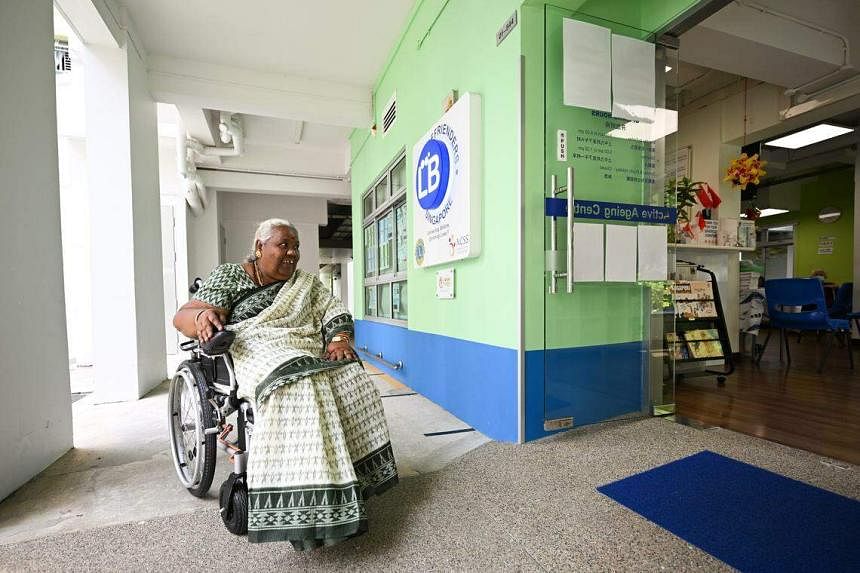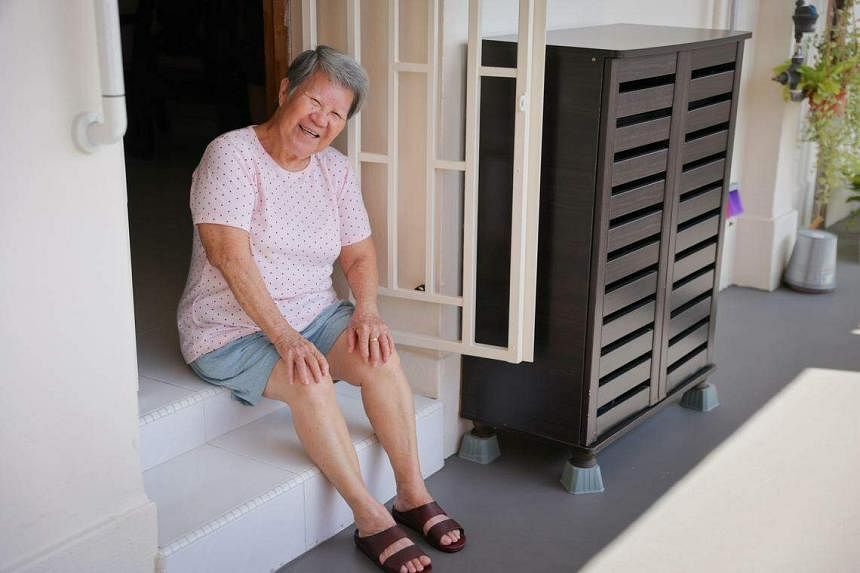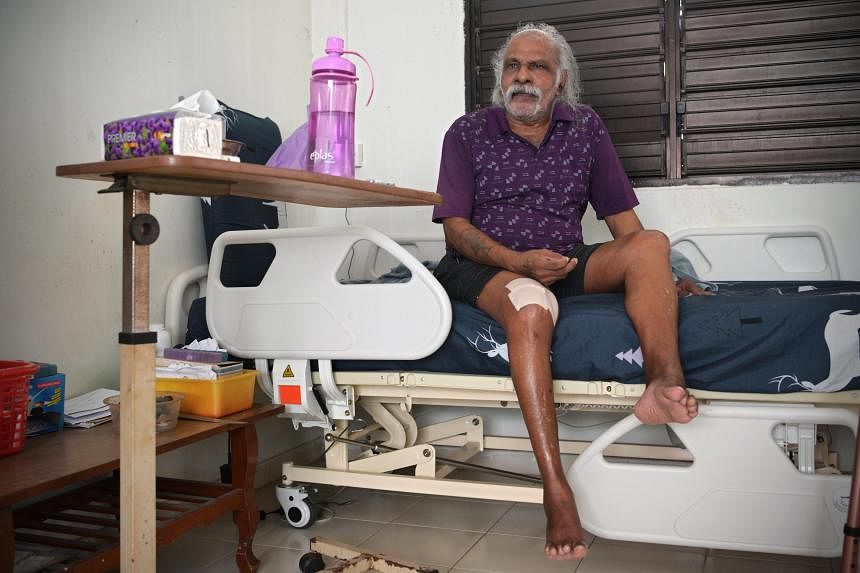SINGAPORE - Ill health keeps Mr Sarmugam R Rajoo, 76, confined within the four walls of his one-room rental flat in Yishun most of the time.
The former security guard collapsed at his workplace eight years ago due to his hypertension, forcing him into retirement. He now relies on the Silver Support Scheme for survival.
In the years since he retired, he developed Parkinson’s disease and osteoarthritis, which gradually stole his mobility. Now, he needs his wheelchair to get around, and does not venture beyond his immediate neighbourhood.
Since 2015, Mr Sarmugam has been under the care of the Home Nursing Foundation, whose staff make monthly home visits to prescribe medications and monitor his health.
A divorcee with no family, he spends most of his time watching television in bed. “I was born lonely with no siblings, and I will stay lonely and die lonely,” he told Insight matter-of-factly.
Mr Sarmugam’s story is far from unique.
In 2021, the World Health Organisation (WHO) said social isolation affects around one in four older adults worldwide. However, this number is higher in Singapore.
A 2015 study by Duke-NUS Medical School’s Centre for Ageing Research and Education (Care) found that two in five Singaporeans aged 62 years and older are lonely.
A more recent study from 2021 using data from the large-scale, long-running Singapore Chinese Health Study also found that older Chinese adults today are at higher risk of social disconnection than before.
This is because family sizes are shrinking, reducing the number of people seniors can turn to for support. As the elderly become frail, their social relationships also become more limited. In addition, the Covid-19 pandemic further impacted social interactions among the elderly.
The Singapore Chinese Health Study, which recruited participants between April 1993 and December 1998, was built as a stable cohort for long-term study of dietary, genetic and environmental determinants of cancer and other chronic diseases in Singapore.
Although this study was based on data collected from Chinese respondents, principal investigator Koh Woon Puay said its findings are applicable to other races.
Professor Koh is working with Associate Professor Feng Qiushi from the Department of Sociology and Anthropology at the National University of Singapore (NUS) to study social disconnection and its impact on the health of older adults in Singapore.
Their work, which involved more than 17,000 older adults aged 61 to 96 years, considered participants to be socially disconnected if they responded in the lowest 10 per cent of a scale of perceived social support, and spent less than one hour a week in groups of more than three with people outside their families.
It found that 6 per cent of seniors are socially disconnected.
Social isolation or disconnection refers to the lack of social, emotional and physical engagement with other people.
While many associate this isolation with seniors living alone, Prof Koh, who is also assistant dean for faculty development and professor of the NUS Yong Loo Lin School of Medicine’s Healthy Longevity Translational Research Programme, told Insight the contrary is true – the most socially disconnected individuals actually live with family members.
“The study found almost four in five elderly who are socially isolated lived with their families, compared with the three in 20 living on their own,” she said.
Among those living alone, men were about twice more likely to be disconnected than women.
Their traditional role as wage earners results in men having smaller social networks and fewer social interactions than women, the study said. The transition from employment to retirement further curtails their social networks, worsening the disconnect.
The biggest enemy
With Singapore set to attain “super-aged” status in 2026, loneliness will become a real threat.
Announcing details of the multi-ministry Age Well SG programme on Nov 16, Health Minister Ong Ye Kung said such isolation is the biggest enemy for many seniors.
“Singaporeans still think that the best support comes from the family,” Prof Feng said. “Even though they have no friends, they think that as long as they have children taking care of them, they are happy. This does not only happen here but also in Hong Kong, Korea, Japan and even India.”
But this is not always true. Family members may be too busy with their own lives and ignore seniors at home; they also tend to be over-protective, stifling the elderly person with their love and concern.
“There was this older woman who declined to go out simply because she was so afraid of falling and becoming a burden to her son,” Prof Koh said. “There was another who was happy to see our researchers, but was afraid that her daughter-in-law would see her talking to strangers... a case of a family member being over-protective in case the elderly got cheated.”
Those who live with family may also have high expectations of support from household members, and develop feelings of social disconnection when this expectation is not met, Prof Feng added.
The study, therefore, found that older adults who are socially isolated and in poor health are more likely to be what Prof Koh referred to as “family restricted”. These seniors face barriers to access to non-family support providers, such as befriending activities with extended members of the community that could fill the gaps and keep them connected to society.
People with lower education, depression and limitations in instrumental activities of daily living that hinder a person’s ability to live independently in the community are far more likely to experience social disconnection, even if they do not live alone.
The study found that those without formal education are almost three times as likely to be lonely compared with those with secondary education.
Those who are cognitively impaired are also 73 per cent more likely to be socially disconnected, and those suffering from depression are 2.5 times more likely to be lonely.
“(Like a car), it is actually better to be sent to the ‘workshop’ for maintenance than the big repair,” Prof Koh said.
“People who are socially disconnected are at a higher risk of needing emergency admission, and the doctors will always tell you that the same disease coming through the emergency room tends to do worse, and may lead to death.”
Studies elsewhere have shown that being lonely has the same effect on mortality as smoking, cardiovascular disease and decreased immunity.
Dr Arthi Premkumar, an associate consultant from the Healthy Ageing programme at Alexandra Hospital, said people who find themselves unexpectedly alone due to the death of a spouse or partner, separation from friends or family, retirement, or even the loss of mobility are at increased risk of death, heart disease and stroke, cognitive impairment and dementia, and mental health issues such as depression, anxiety and suicide.
“Loneliness and social isolation trigger complex biological pathways across multiple systems, like cardiovascular, nervous and hormone regulatory systems. For example, the body can be in a state of chronic inflammation, or there are changes in blood vessels, which affect the heart and nervous system,” she said.
Dr Arthi said isolated seniors are also less likely to be active and engage in health-promoting behaviour, and more likely to be non-compliant when it comes to medications and medical appointments.
She added that such seniors tend to be both socially and physically frail.
“Social frailty is the progressive loss of resources and the ability to participate in social activities to fulfil basic social need. This is closely linked to physical frailty when they get into a state of decreased reserves and resilience in the face of diseases and stress,” she said.
To reverse this, the Government is reviewing its strategy to help the elderly socialise more and engage in more physical activities that can help delay – or even prevent – frailty and deterioration.
Health Minister Ong also called for Active Ageing Centres to be transformed into a “magnet” for seniors to get them out of their homes and help them stay healthy and socially connected.
One senior who has benefited from such support is Madam Letchimi Vetrivelu.

The 69-year-old, who has diabetes, hypertension and uses a wheelchair, treats the Lions Befrienders’ Active Ageing Centre at Block 494E in Tampines as her second home, and its staff as family. It was three years ago, through the Lions Befrienders’ Befriending and Budding Services, that she got to know befriender Oh Jing Yi.
“I tell her all my problems. She’s like my daughter. She’s a godsend,” Madam Letchimi said.
The housewife’s late husband, a shipyard safety officer, died of sickness 12 years ago. She now lives alone in a one-room rental flat in Tampines, and depends on government schemes such as ComCare assistance and the Silver Support Scheme.
Despite her mobility issues, Madam Letchimi goes on outings with Lions Befrienders to the Istana and Gardens by the Bay, and volunteers at the Sri Mariamman Temple in Chinatown weekly. She even takes the bus to Tekka on her own to buy groceries.
From family to community
In a commentary written for The Straits Times in May, Dr Ad Maulod, cultural anthropologist and senior research fellow at Care, and Associate Professor Angelique Chan, the centre’s executive director, said strategies to combat loneliness are evident in the refreshed Action Plan for Successful Ageing led by the Ministry of Health (MOH), and underpinning it is the realisation that Singaporeans “cannot live their fullest lives as hermits”.
Singapore has adopted a comprehensive approach to social isolation, using the A-B-C model of active ageing, befriending, and care and support in the community.
For instance, the Community Networks for Seniors scheme facilitates activities such as fitness classes and arts and crafts sessions, while the Silver Generation Office carries out outreach work, referring those living alone and facing the risk of isolation to befriending programmes and services to assist with daily activities.
But this model does not address the root causes of loneliness in later life, wrote Dr Maulod and Prof Chan in their commentary. They said most lonely seniors wanted to connect with peers of similar background and experience. This group also wanted to discover new experiences to alleviate boredom, but needed encouragement to do so.
Associate Professor Thang Leng Leng, an NUS anthropologist and president of the Gerontological Society of Singapore, said the higher proportion of older persons living alone and the increased rate of singlehood in recent years means there should be more support for ageing in place, with community-based care and support services within walking distance of a person’s home.
“Our family structure and living arrangements have changed. We have been more of a family-centric society but we now have fewer children, or they can be overseas or living apart,” she said.
This does not mean social isolation is inevitable.
“Singapore is doing the right thing by focusing on the kampung spirit, or community spirit,” she said. “We always relate loneliness to social disconnection, but it’s really about the person’s engagement and communications.”
She cited how seniors in Hong Kong make it their way of life to meet up with friends for yum cha (Cantonese for brunch involving Chinese tea and dim sum), for example.
She added that seniors here can renew ties on digital platforms such as Facebook, or by joining social groups such as school alumni networks.
The individual’s mindset also plays an important role.
Madam Chan Woon Siong, 82, is home alone in her three-room flat in Ang Mo Kio most days, and prefers it that way. Her daily routine involves waking up at 5.30am, reciting Buddhist chants for an hour, and having a simple breakfast of bread and eggs before taking a short stroll around her estate.
She returns home to do housework and prepare lunch. In the afternoon, she watches Cantonese opera and Chinese dramas on her mobile phone, then prepares her dinner at 4.30pm.

She enjoys her solitary life – which she has lived since her divorce around 30 years ago – and admits she has hardly any friends.
“Most of my friends have migrated to heaven,” she said. “I cannot relate to younger people because they speak mostly English, which I don’t understand, instead of Mandarin and dialects like Cantonese.”
“I used to get calls from friends, telling me that their grandchildren were getting married,” she added. “These days, I seldom get calls and if I do, they would be about who’s gone from this world.”
She has no children and her only sibling – her elder brother – has died. Her only relative is her nephew, who visits occasionally and helps her read some of her English mail.
She does not venture far beyond her estate to buy necessities and food. She has hypertension and failing eyesight, and previously experienced a few falls that weakened her legs.
The Singapore Red Cross (SRC) has reached out to her for befriending and invited her on its outings for the elderly. Madam Chan is also a beneficiary of SRC’s Home Monitoring and Eldercare service, or HoME+, which provides seniors with a helpline for non-emergency situations and a monitoring, alert and response system for home safety. However, she prefers to be alone at home.
“I need to protect myself because of my weak legs,” said Madam Chan, who wears rubber slippers at home to prevent herself from slipping. “If I were to fall, I would bother my nephew, and I don’t want to do that because he has his own family.”
Madam Chan added that she is used to this life.
“I am alone, but not lonely.”
Ageing in place – Lessons from Queenstown
Queenstown is Singapore’s first satellite town and has one of the oldest populations in Singapore, with almost one out of every four Singaporeans aged 65 and above living there. It was designated as the pilot site for the development of a health district in October 2021.
The Government has intended it to be a testing ground to trial integrated solutions that enhance the health and well-being of Queenstown residents throughout their various life stages.
These include the rejuvenation of existing precincts to create more senior-friendly neighbourhoods, with amenities like therapeutic gardens, exercise trails and new fitness equipment to promote active ageing, social interaction and intergenerational bonding.
With a growing preference among the elderly for ageing in place, the Government has also launched community care apartments (CCA) for home buyers aged 65 and above. This is an assisted living public housing option that gives seniors access to care services, social activities and amenities.
The first batch of such apartments, in Bukit Batok, went on sale in February 2021. In November 2022, about 240 apartments were launched in Queenstown as part of the Queensway Canopy Build-To-Order development situated in the Queenstown health district.
These are built alongside blocks of three-room and four-room flats and aim to promote intergenerational bonding and foster inclusivity within the wider community. They are paired with essential services such as 24-hour emergency monitoring and response, and basic health checks.
Seniors who require help with their activities of daily living, or household services such as meal delivery, laundry and housekeeping, may opt in for these services at additional cost. With care services that can be scaled according to the individual’s care needs, the CCAs will facilitate seniors to age in place independently. Queensway Canopy will also feature a Social and Wellness Hub, located beside the CCA block.
The Queenstown health district also established Singapore’s first Ibasho project, led by Associate Professor Emi Kiyota of NUS, in partnership with non-profit community care service, FaithActs.
Ibasho means “a place where you can feel like yourself” in Japanese, and advocates the recognition of older persons as valuable assets to their community.
A new Active Ageing Centre is being developed by FaithActs, integrating Ibasho’s eight principles: elder wisdom, normalcy, demarginalisation, community ownership, multigenerational, culturally appropriate, resilience and embracing imperfection.
Queenstown residents are actively involved in planning this centre’s development, giving them a purposeful life and motivating them to do things, such as encouraging them to volunteer and contribute to the community.
Mr Eric Chua, Senior Parliamentary Secretary for Social and Family Development, as well as Culture, Community and Youth, said social isolation will be a growing problem if older people are not engaged and seen as assets, or able to continue contributing to family and society.
“Several factors would need to be addressed – ageism, poor health, financial insecurity, weak social networks, not working, difficulty with accessing public transport, the digital divide and fear of using digital technology due to scams,” said Mr Chua, who is MP for Queenstown in Tanjong Pagar GRC.
Otherwise, Singapore’s fast-ageing population is likely to bring to mind the Beatles’ song Eleanor Rigby, with its plaintive questions:
All the lonely people
Where do they all come from?
All the lonely people
Where do they all belong?

